Do you know the secret to having a freshwater tank filled with vivid fish and thriving plants without a lot of extra effort? I’ll give you a hint; it’s not your substrate, lights or water conditioners. When it comes to maintaining your day-to-day water quality, the most important factor is having the best aquarium filter.
Filtration options have expanded over the last few years as new types have come to market and older systems have been refined. Choosing the best filtration system for a freshwater fish tank of any size is easier than ever, and most systems are quite affordable!
Quick Comparisons of the 10 Best Aquarium Filters
| IMAGE | BRAND | DETAILS | |
|---|---|---|---|
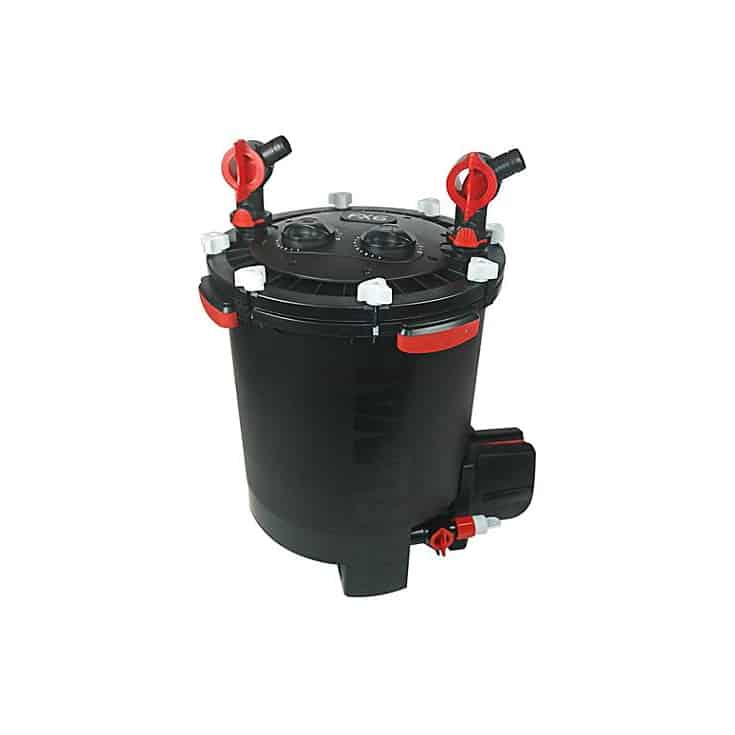 | Fluval FX6 Canister Filter |
| View Product |
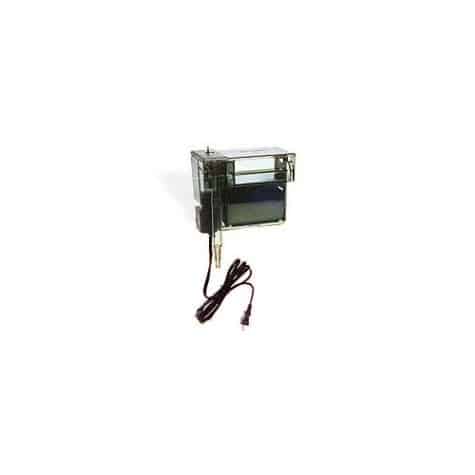 | AquaClear HOB Power Filter |
| View Product |
 | Marineland Penguin Power Filter |
| View Product |
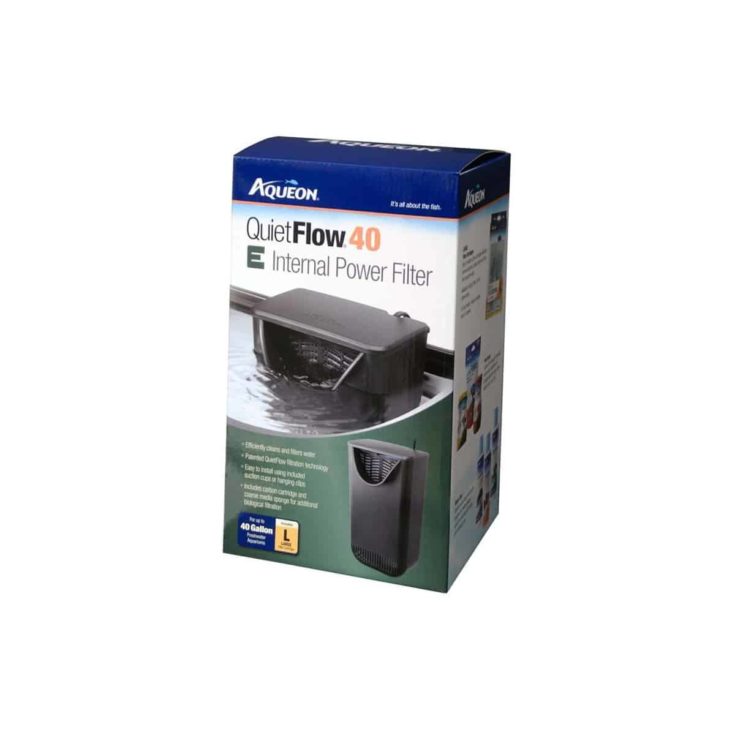 | Aqueon Large Filter Quietflow Internal |
| View Product |
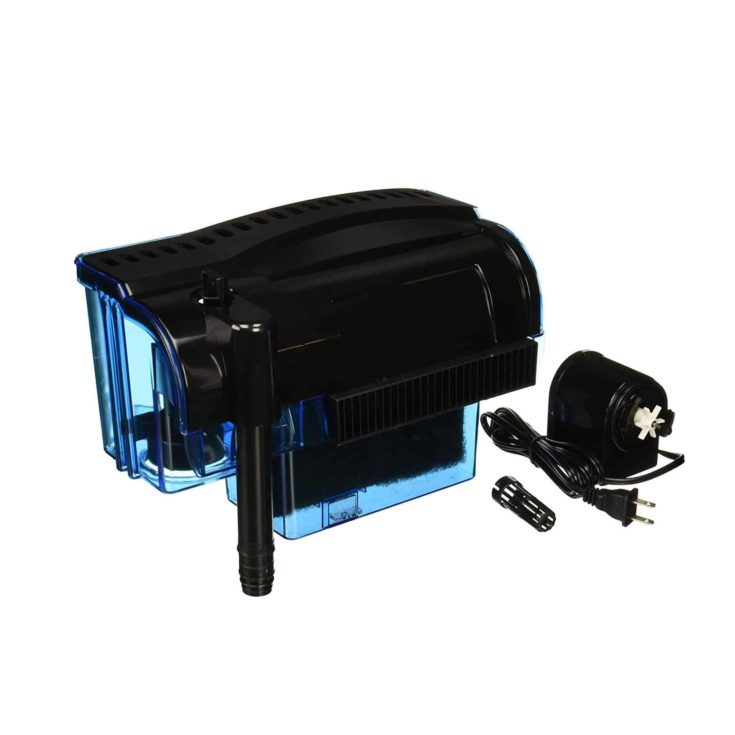 | Penn Plax Cascade HOB Filter |
| View Product |
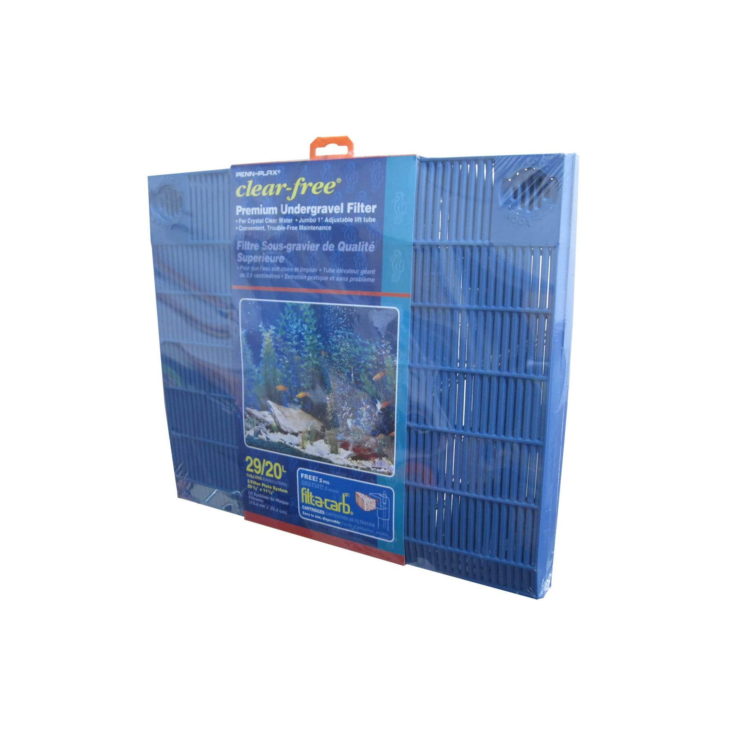 | Penn Plax Premium Undergravel Filter |
| View On ChewyView On Amazon |
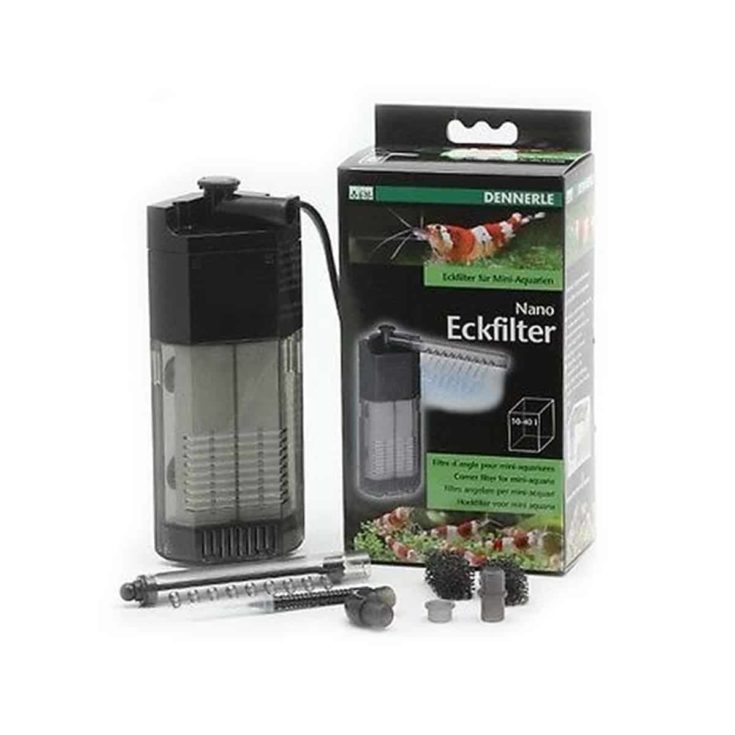 | Dennerle Internal Corner Power Filter |
| View Product |
 | Hydro 3 Sponge Filter |
| View Product |
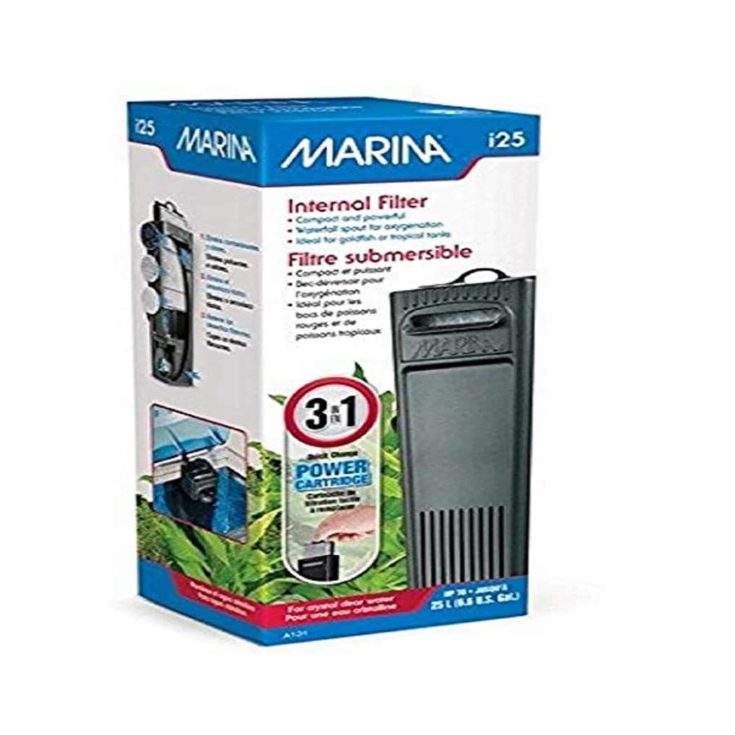 | Marina Internal Power Filter |
| View Product |
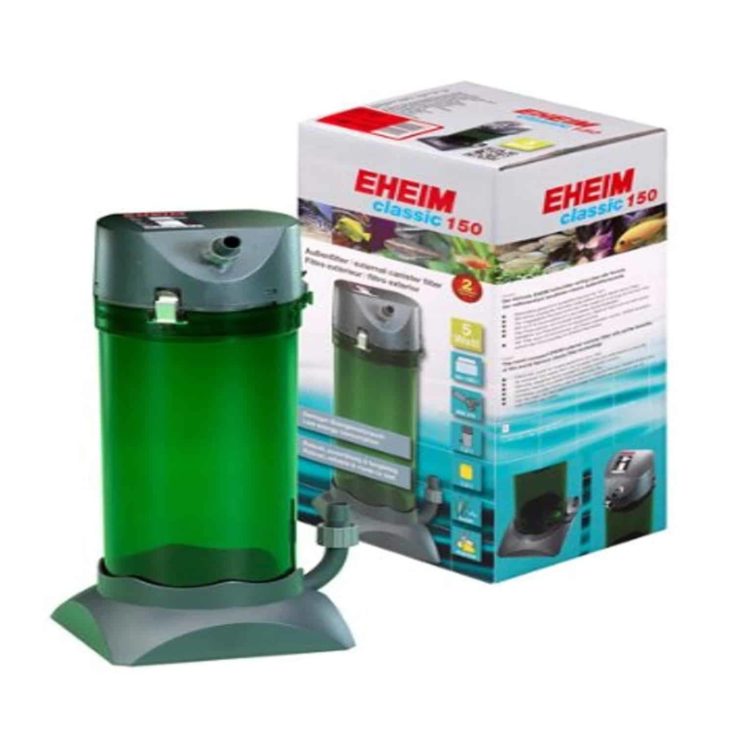 | EHEIM Classic External Canister Fish Tank Filter Media |
| View Product |
Top 10 Aquarium Filter Reviews
Let’s take a look at some of the best filters on the market for freshwater aquariums! These filters were chosen because they are manufactured by popular brands, have the latest in filter technology and are easy to find replacement parts for. I can safely say that I would buy these filters myself and in some cases already have.
1. Fluval FX6 Canister Filter

- Style: Canister
- Capacity: Up to 400 Gallons
- Dimensions: 15.75 x 15.75 x 20.8 inches
- Flow Output: 925 GPH
If you want a professional aquarium filter for a large aquarium up to 400-gallons, then the Fluval FX6 is an excellent option. It’s so packed with features that I can’t even list them all here. The FX6 is a high-performance filter that is self-priming and practically leak-proof. You can even use it to perform water changes with an accessory kit!
One of the most impressive features are the stackable media baskets. You can customize your filter media, and the seals prevent the water from bypassing the baskets. The auto-stop valves also prevent water from leaking or back flowing into your tank.
| PROS | CONS |
|---|---|
|
|
2. AquaClear HOB Power Filter

- Style: HOB
- Capacity: 20 to 50 Gallons
- Dimensions: 4 x 9 x 8 inches
- Flow Output: 200 GPH
If you’re looking for an HOB filter for a bedroom aquarium or one in a location where the sound could be bothersome, then the AquaClear power filter could be the best pick for your home. It’s the quietest filter on my list and one of the least-noisy HOB filters I’ve ever used. It would also work well alongside a canister system!
There’s really nothing fancy about this filter, and that’s to its benefit. One reason it is so quiet is that it lacks a “bio-wheel” and doesn’t splash as much water as some HOBs. The flow rate is adjustable and suitable for delicate fish and shrimp aquariums. It’s a surprisingly durable filter and has a great two-year warranty.
| PROS | CONS |
|---|---|
|
|
3. Marineland Penguin Power Filter

- Style: HOB
- Capacity: Up to 30 Gallons
- Dimensions: 8.25 x 6 x 7.38 inches
- Flow Output: 150 GPH
I’ve personally owned at least 10 Marineland power filters of varying sizes and I certainly think these are some of the best premium HOBs around. They offer reliable 3-stage filtration with an adjustable flow rate, and I’ve rarely had problems with the water by-passing the media.
A signature feature of this filter are their patented “Bio-Wheels” for maintaining colonies of good bacteria. There’s probably no other HOB who does bio-filtration as well. But those wheels dramatically increase the noise and the mess from the splashing water. If you have hard water, you’ll spend a lot of time removing deposits from your tank.
| PROS | CONS |
|---|---|
|
|
4. Aqueon Large Filter Quietflow Internal

- Style: Internal
- Capacity: Up to 40 Gallons
- Dimensions: 6.5 x 5.69 x 11.19
- Flow Output: 290 GPH
One of the best 40-gallon aquarium filters is this internal Quietflow model from Aqueon. It hangs or is suction-cupped to the inside of your tank, sort of like a HOB but hanging inside your tank rather than outside. This is an excellent option for a planted tank that doesn’t have a large number of fish.
I wouldn’t use this filter with delicate species, however, because you can’t adjust the flow rate to the gentle currents they prefer. In some tanks, it may be awkward to reach into the filter to change the media as well. It’s still the option I’d likely go with for a plant-focused tank up to 40-gallons, and it’s very reasonably priced too.
| PROS | CONS |
|---|---|
|
|
5. Penn Plax Cascade HOB Filter

- Style: HOB
- Capacity: 50 to 100 Gallons
- Dimensions: 9 x 6.5 x 11 inches
- Flow Output: 300 GPH
For the best 100-gallon aquarium filter, consider this HOB-style device from Penn Plax. It’s actually a surprising workhorse of a filter when you consider its budget price. Like many HOBs, the Penn Plax offers 3-stage filtration but unlike most, they have a separate compartment that slowly cleans the water biologically.
This filter has a high 300-GPH flow and the rate is easily adjustable, so you can turn it down during mealtime and prevent the food from being sucked into the intake. It has a fairly quiet motor as well, though not as quiet as the AquaClear. This is an all-around solid choice for a large aquarium!
| PROS | CONS |
|---|---|
|
|
6. Penn Plax Premium Undergravel Filter

- Style: Undergravel
- Capacity: Fits 20-Gallon Long or 29-Gallon Tanks
- Dimensions: 28.5 x 11.5 x 1.2 inches
- Flow Output: Variable- Depends on Air Pump
I don’t generally recommend undergravel filters very much these days since we have so many other options that work as well or better. But for planted tanks, sometimes an undergravel is the least expensive and easiest option. This model from Penn Plax is a typical undergravel system for a new aquarium. Just add an air pump for power!
While undergravel systems leave debris behind in your substrate, this is less of a problem for planted tanks that don’t have many fish. As long as your bio-load isn’t too heavy, the Penn Plax will provide enough filtration and circulation to keep your plants happy. You won’t have problems with dead zones in your substrate, either!
| PROS | CONS |
|---|---|
|
|
7. Dennerle Internal Corner Power Filter

- Style: Internal Submersible
- Capacity: Up to 20 Gallons
- Dimensions: 7.7 x 3.9 x 2.4 inches
- Flow Output: 40 GPH
I wish this type had been available when I was a child because I would have loved to have had this internal corner power filter from the German company Dennerle! It’s an internal submersible filter that discretely hides in the corner of your tank and has an adjustable spray bar for the outflow.
The Dennerle is very quiet and the 40 GPH is suitable for Bettas and shrimp. But the 3-stage filtration is also adequate for raising goldfish and planted aquariums. While you do have to reach into your tank to change the pad and media, it’s really easy to do and you don’t have to remove the entire thing to access the innards!
| PROS | CONS |
|---|---|
|
|
8. Hydro 3 Sponge Filter

- Style: Sponge
- Capacity: Up to 15 Gallons
- Dimensions: Variable
- Flow Output: Depends on air pump
Sponge filters are usually simple single-stage devices but this option from Hydro also offers biological filtration on top of the mechanical for longer term use. It’s an excellent option for raising fish and shrimp fry, and while you don’t need bio-filtration in hospital tanks you can still use the Hydro for them as well.
| PROS | CONS |
|---|---|
|
|
9. Marina Internal Power Filter

- Style: Internal
- Capacity: Up to 6.6 Gallons
- Dimensions: 3 x 3.2 x 8 inches
- Flow Output: 24.6 GPH
One of the best uses for an internal filter is in a nano tank, and this system from Marina is a classic! Similar to the Aqueon, the Marina hangs inside your tank and is accessible from the top. It slowly filters your water through a multi-stage one-piece replaceable cartridge and gently returns it to your tank.
This is an excellent option for tanks up to 6-gallons. I doubt the level of biological filtration is very high since it gets replaced along with the other stages. But this durable little filter gets the job done and it’s nearly as easy to use as a sponge filter.
| PROS | CONS |
|---|---|
|
|
10. EHEIM Classic External Canister Fish Tank Filter Media

- Style: Canister
- Capacity: Up to 20 Gallons
- Dimensions: 6 x 4.3 x 11.4 inches
- Flow Output: 40 GPH
I wouldn’t usually recommend a canister system for a small 20-gallon tank but there’s always exceptions to the rules. Sometimes, you really do need a high level of filtration for a small tank. If you have goldfish or a planted female Betta sorority you’ll likely love this canister filter from the top-quality brand Eheim.
My favorite feature is the built-in canister stand which prevents the filter from tipping over. I’ve had canister filters leak when tipped, so this is a definite bonus. The silicone seals offer a durable and long-lasting water-tight closure, and they are easily replaced when they wear out. This is a very customizable and flexible system.
| PROS | CONS |
|---|---|
|
|
Guide to Aquarium Filtration Systems
Modern filtration systems are an efficient and easy way to keep your water free from debris and neutralize biowaste without having to do weekly water changes. Before I can pass on my tips for choosing the best freshwater aquarium filters, we need to talk about their features and which types are ideal for different aquarium set-ups.
How Filters Clean Aquariums
There are three ways a filter can function to keep your aquarium water clean. Think of these as stages. Some filters have multiple stages and clean your water in two or three ways, while others use a single stage.

Stage 1–Mechanically Collects Debris Floating in Tank
Filters mechanically remove debris by passing the aquarium water through a fine mesh or wadding of cotton, called the filter pad or sponge filter. This is the action most associated with filters, and nearly all types have this primary stage.
Stage 2–Chemically Neutralizes Toxins Using Filter Media
Many filters use chips of activated carbon or a resin to absorb toxins from your aquarium water. Filter media are replaceable and usually sit in a bag, cartridge or internal basket inside your filtration system. This is the second most common function you’ll see available in aquarium filters.
Stage 3–Biologically Converts Fish Waste into a Safer Form
This one sounds complicated, but it really isn’t. Some filters have a stage designed to promote the growth of “good” aquarium bacteria. This bacteria consumes the dangerous ammonia and nitrites in your water and converts it to a safer form, so your fish don’t get stressed or sick (your substrate is a reservoir of healthy bacteria too).
These biological stages come in many forms. Some HOB filters have a “bio-wheel” for the bacteria to grow on, while others use inert ceramic rings in a stage inside the filter. This used to be the least common stage and only found in premium filters, but these days many budget filters offer them as well!
Types of Aquarium Filters

What’s the best type of aquarium filter? It depends on your tank size, substrate, and the type of aquatic organisms you’re keeping. Filter styles have undergone a lot of refinement over the last 15 years and many hybrid systems have been introduced.
One thing that may be confusing for novice fish keepers is the term “power or powered” filtration system. It simply means the filter runs off electricity rather than using an air pump to move the water through the stages. The types of filters you’ll most likely see for sale include:
Sponge Filters
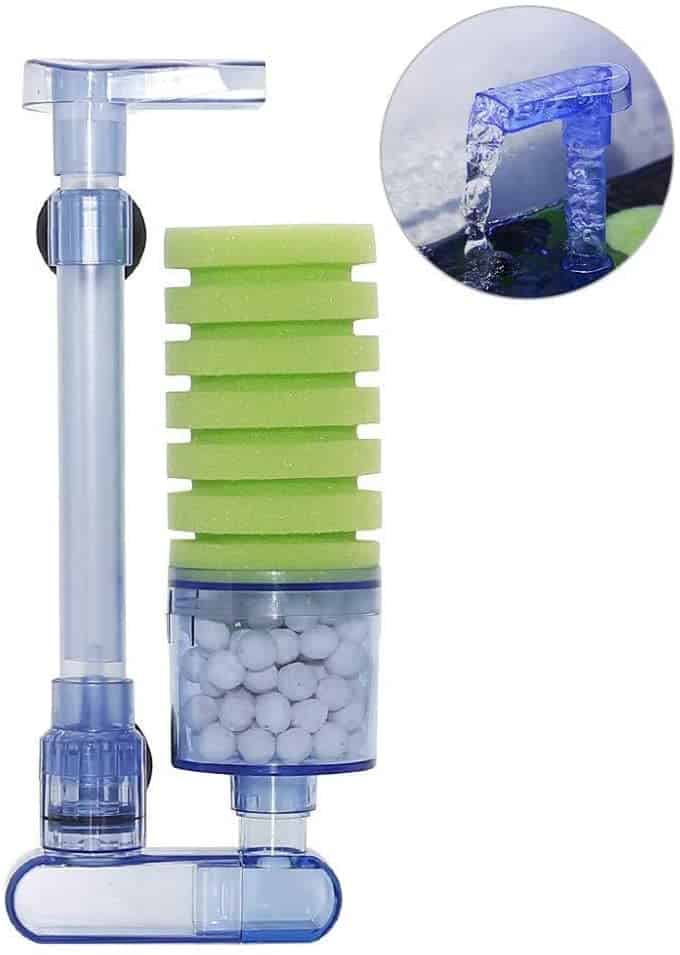
Sponge filters were once the simplest type, used mostly for hospital and breeding tanks and raising fry. They are a very gentle filtration system powered by an air pump that sucks your dirty water through a fine sponge-covered intake. Their primary job is to remove large visible debris and waste from your aquarium water.
Modern sponge filters can also include a biological stage, which may only be helpful if you’re using it in a tank longer-term rather than for a sick fish. Their ability to filter out debris is limited and they require weekly cleaning to prevent them from being clogged. It takes a month of use to cycle your water and establish healthy bacteria.
I keep sponge filters on hand for emergencies, but they don’t offer enough filtration for my planted tanks or large community set-ups. Since they can’t chemically neutralize ammonia I don’t rely on them as my primary form of filtration. But they are a very good option for small Betta or freshwater shrimp aquariums!
| Pros | Cons | Ideal Filter For: |
|---|---|---|
|
|
|
Internal and Submersible Filters

One of the newer types are the internal and submersible filters that fit inside your aquarium. These may be simple 1 or 2-stage devices perfect for fish bowls and nano tanks, or more robust 3-stage filters that can be hidden in a lower corner of your fish tank. They may be either electrical or powered by an air pump.
Depending on their size and number of stages, they can offer a lot of filtration power to the right set-up. They are ideal for smaller tanks that don’t have the surrounding space to fit an external HOB or canister filter, or for larger low-current goldfish and shrimp aquariums.
Some of the 3-stage electrical models have a sufficient flow rate to work well for planted aquariums, as long as there aren’t too many fish or bottom feeders in the tank. The simpler air-pump powered models are usually inadequate for planted or larger community fish tanks but do well in small set-ups.
| Pros | Cons | Ideal Filter For: |
|---|---|---|
|
|
|
Undergravel Filters
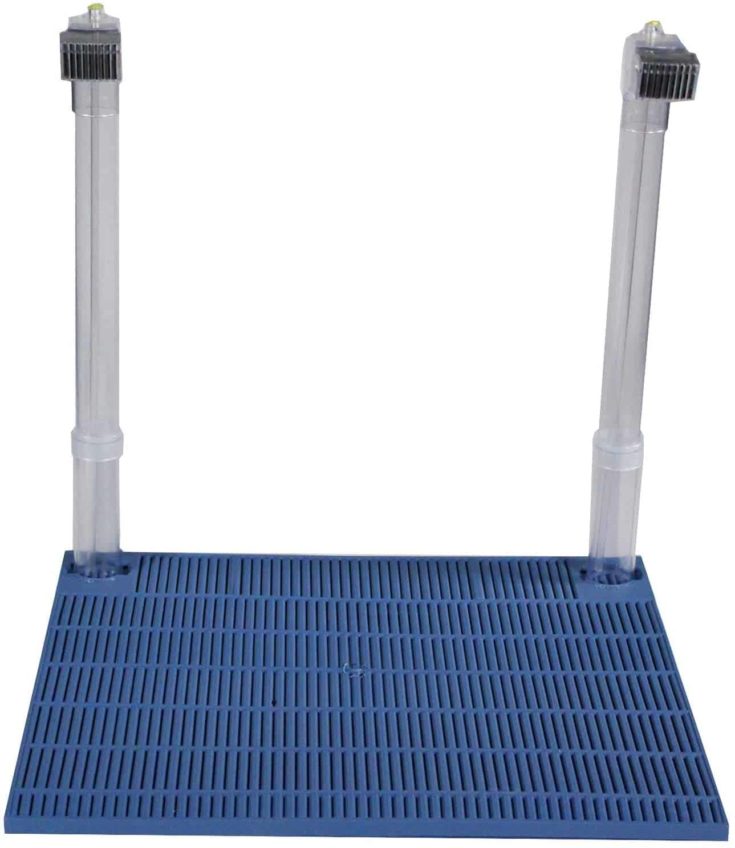
There are three parts to an undergravel filter: a plastic mesh screen which is placed under your gravel substrate, an outflow tube with a replaceable cartridge holding the filter pad and media, and an air pump connected with plastic tubing to power the filter. You’ll usually have to buy the pump and plastic tubing separately from the filter.
Undergravel filters provide limited 2-stage filtration by drawing the dirty water through your substrate before it passes through the filter pad/media. Larger particles and debris are caught in your substrate and broken down by the bacteria or may be removed by your bottom feeders or when vacuuming gravel during water changes.
Undergravel filters were once considered the ideal entry-level model for novice aquarists, and many of us started with these simple systems. But budget internal and submersible filters provide better filtration at a similar cost and are much easier to maintain. I can’t honestly recommend undergravel filters over the other options.
PROS
- Filter is mostly hidden underneath the gravel, with just the outflow and air tubing visible
- Set-up is inexpensive and easy to install in a new aquarium
- Since they cover the entire bottom of the tank, these filters help prevent “dead zones” from forming
CONS
- Filtration ability is at best moderate and most debris end up decaying in the substrate
- Limits your options for substrate, as they don’t work with sand, soil or fine gravels
- Few brands to choose between and once installed are nearly impossible to adjust without breaking down the entire tank
IDEAL FILTER FOR:
- Nano, Betta, goldfish and shrimp tanks
- Planted tanks under with a low number of fish/bottom feeders
HOB Filters

HOB or “hang on back” filters are one of the most popular types on the market and a really good option for fresh or saltwater fish tanks. They hang externally on the side or rear of your tank and have an intake tube that carries the water up to the filter for cleaning. It’s easy to maintain these types without putting your hands in your tank!
The main unit houses the electrical pump (impeller) and filtration stages. The water is pulled up the intake tube and cycled through the stages, and then returns to the tank through the outflow vent. HOBs offer 2 to 3-stages of filtration and a flexible set-up that is easily modified to suit most any aquarium.
HOBs are more complex to set-up and maintain than sponge, submersible and undergravel filters. Cheaper models closely resemble simple internal types and provide about the same level of filtration. Premium 3-stage HOBs may be as effective as canister filters and they are often used in tandem for large or planted tanks.
| Pros | Cons | Ideal Filter For: |
|---|---|---|
|
|
|
Canister Filters
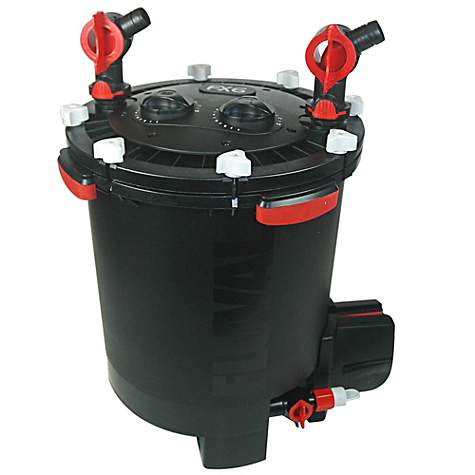
Canister systems used to be the filter-of-choice for professional and experienced fishkeepers who kept large 50 to 500-gallon aquariums. These powerful electric filters are usually placed underneath your aquarium and are hidden by the stand. The water is pulled from the intake into the canister, which houses the filter pad and stages.
One advantage of a canister filter is their ability to move a lot of water through the stages, which make them ideal for very large tanks. Since the canister is sealed closed, less water is lost to evaporation and the noise level is lower than with HOBs. The outflows are adjustable to minimize the current and splashing.
Canisters often have multiple filter pads to polish the water and remove microscopic debris. You can usually customize the other stages to provide the exact mix of chemical-neutralizing and biological media that your tank needs. But they are more complicated to operate and maintain, and usually cost more than other types.
| Pros | Cons | Ideal Filter For: |
|---|---|---|
|
|
|
Wet/Dry Filters (Sumps)
I’m only going to cover wet/dry filters, also known as sumps, briefly here because you rarely see these complex systems used in freshwater aquariums outside the professional world of aquascaping. They can be an important part of maintaining a saltwater or reef tank, however.
A sump system is a slow, gradual way of providing biological filtration to a large aquatic system. A sump usually sits directly under or next to a saltwater aquarium, and holes or a siphon overflow allows water to trickle into the sump via gravity. As the water moves through the stages it is oxygenated and cleaned by bacteria.
Sumps are complicated to set-up, take up as much room as your aquarium and provide mainly passive biological filtration, though some systems also have slots for filter media. They are also quite expensive. I don’t recommend them for freshwater aquariums. For external fish tank filters, I’d go with an HOB or canister instead.
| Pros | Cons | Ideal Filter For: |
|---|---|---|
|
|
|
Filter Type
Sponge
# of Stages
1 to 2
Typical Initial Cost
Inexpensive
Power Source
Air Pump
Ease of Use
Simple
Filtration Ability
Very Limited
Filter Type
Internal
and Submersible
# of Stages
1 to 3
Typical Initial Cost
Varies by model but usually inexpensive
Power Source
Air Pump and Electric Models Available
Ease of Use
Simple to Moderate
Filtration Ability
Variable by model but limited to moderate
Filter Type
Under
gravel
# of Stages
1 to 2
Typical Initial Cost
Inexpensive
Power Source
Air Pump
Ease of Use
Simple
Filtration Ability
Limited
Filter Type
HOB
# of Stages
2 to 3
Typical Initial Cost
Varies widely by model and brand
Power Source
Electric
Ease of Use
Moderate
Filtration Ability
Usually Moderate to High
Filter Type
Canister
# of Stages
3
Typical Initial Cost
Varies widely but usually more expensive than HOBs
Power Source
Electric
Ease of Use
Moderate to Complex
Filtration Ability
Moderate to High
Filter Type
Wet/Dry
# of Stages
1 to 2
Typical Initial Cost
Pricy to purchase and install
Power Source
Gravity with powered return system
Ease of Use
Complex
Filtration Ability
Limited to biological and possibly some chemical filtration
Tips for Finding the Best Freshwater Aquarium Filter
Now that you know all about the types of filters and their benefits and disadvantages, let’s talk about how you can go about selecting the best option for your aquarium. How much filtration does your tank need? It depends, and as you add species and adjust your aquarium set-up your filtration needs may change.
Aquarium Size and Type of Occupants

For smaller aquariums 10-gallons and under, you’ll most likely be choosing between the inexpensive and low-flow sponge, undergravel, internal or submersible systems.
Submersible and internal types provide better mechanical and chemical filtration for healthy Betta, shrimp, and plants than sponge or undergravel systems.
HOBs are a great option when you need more filtration, such as for goldfish and planted tanks. They come in the widest range of sizes of all the systems and are suitable for tanks from 5 to 500-gallons. There are so many brands and price points that I recommend reading the aquarium filter reviews before selecting your model.
Canister filters are usually way too powerful for tanks under 20-gallons. You can definitely have too much current and circulation for your fish’s comfort, especially if you’re keeping Bettas or goldfish. But for planted tanks and large community aquariums over 50-gallons a canister can be a great cost-effective option.
Flow Rate

Powered filtration systems are usually rated by their flow rate, or the number of gallons cycled through the filter every hour (gallons per hour or GPH). These are approximate rates, and the way you set-up and maintain your filter will directly impact the flow in your tank. If your filter pads are clogged with debris it will dramatically reduce your rates.
There is a lot of argument over the ideal flow rate for an aquarium, and truthfully it really depends on your tank. Some sites recommend getting a filter with a GPH that’s up to 6 times the capacity of your tank. Personally, I’ve found this to be too much for most of my tanks. A 20-gallon set-up usually does not need a filter rated at 120 GPH.
My rule of thumb is to choose a filter that provides 2 to 4 times the GPH of my tank, so around 20 to 40 GPH for a typical 10-gallon tank. For larger aquariums, I usually get better results from using multiple filters with lower rates spread throughout the tank than a single high-capacity filter. You’ll have to see what works best for you.
Filtration Technology
Choosing the best filtration system for fish tanks doesn’t necessarily mean picking the newest or most advanced model. Afterall, sumps operate on a very old and simple principle even if they are complicated to set-up and maintain. The fancier your filtration system the more than can also go wrong with it.
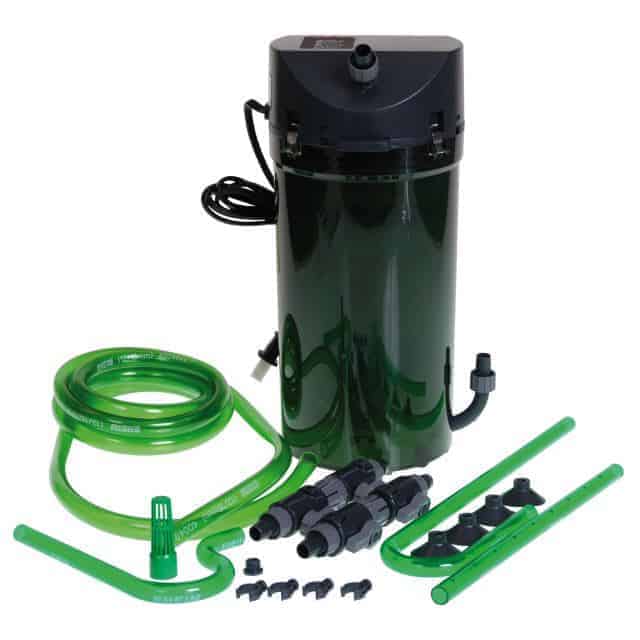
Instead, I look for proven systems that have already stood the test of time in many tanks around the world. A good, basic filter can often do the same or even a better job as one packed with technological features. Rather, focus on filters with features that make them easy to maintain, like silicon seals and accessible pads and media.
Brand
I’m not a very brand-loyal person in my day-to-day life, but years of aquarium keeping have definitely made me wary of some aquatic companies. I avoid off-market filters or those made by unknown brands for a few reasons.
First, it’s safer to go with a brand you can easily find replacement parts and filter pads/media for locally and online. I once had to wait for 8-weeks for a small shipment of cartridges from Asia from an off-brand filter company and my fish were miserable.
Products and known brands with a proven track record also often turn out to be more cost-effective in the long run. Parts like the impeller tend to last longer so you don’t have to replace them as often. You can also find advice for modifying your filter in online forums. A cheap filter that leaks can do a lot of damage to your floors, too.
Conclusion

The secret to maintaining a sparkling clean aquarium without a lot of extra effort is having the best fish tank filter you can afford. The best option will depend on your tank’s size and set-up, and many do best with more than one type of filter. You can always add another filter as your tank and fish mature.
For nano tanks and small aquariums under 20-gallons the Marina, Hydro, Penn Plax and Dennerle are all viable options.
- It just depends on whether you prefer an internal, sponge, undergravel or submersible system.
- I’d probably opt for the Dennerle if it would work for my tank.
For the mid-size range from 20 to 75 gallons the Eheim, Penn Plax, AquaClear, Marineland are all solid picks depending on the features you need and the type of fish and plants you plan to keep. Steer clear of the Marineland if you have really hard tap water, though, or you’ll have a lot of build-up to clean from your tank.
For larger tanks over 75-gallons you’d do best with the AquaClear or the excellent, premium Fluval FX6 for tanks from 250 to 400-gallons. I’m tempted to start a 400-gallon aquarium just to justify getting the Fluval myself.
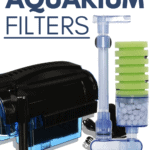
Very detailed info. Thank you